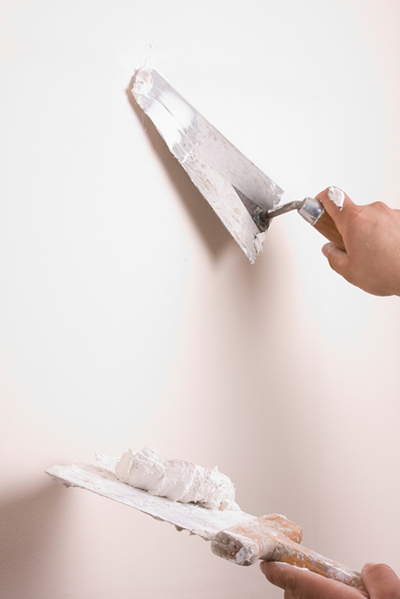Drywall, the long, thin sheets of chalky white material used to create the walls in homes and businesses, is a favorite of contractors for its affordable price and ease of installation.
The California Department of Resources Recycling and Recovery reports that 15 million tons of drywall is produced in the U.S. every year. Only a fraction of that drywall ends up being recycled because many people are unsure where to take it. We share ideas for finding recyclers who can turn used drywall back into useable products.
 The primary component in modern drywall (also known as plasterboard, wallboard and by the brand name Sheetrock) is gypsum, a naturally occurring substance made of calcium sulfate and water. Calcium sulfate is found in ancient seabeds that have dried up, leaving rich deposits of sulfates behind. Gypsum is naturally fire resistant, making it a perfect material for home construction.
When combined with water, gypsum makes a paste that can easily be applied to surfaces or modeled into shapes (for example, the long panels that form your walls). To make drywall panels, gypsum is combined with thickening agents, spread on top of long sheets of paper and dried in a kiln. The most common size for drywall sheets is 4 feet wide by 8 feet long, although they also come in 10-foot and 12-foot lengths.
While drywall is the most common item made from gypsum, the material has several other uses. Gypsum is great for neutralizing the pH of acidic soils. It helps retain water in sandy soils and it softens clay soils. Composters and fertilizer manufacturers often include it in their products because of its soil amendment properties, and cement makers use it to keep cement from setting too quickly.
The primary component in modern drywall (also known as plasterboard, wallboard and by the brand name Sheetrock) is gypsum, a naturally occurring substance made of calcium sulfate and water. Calcium sulfate is found in ancient seabeds that have dried up, leaving rich deposits of sulfates behind. Gypsum is naturally fire resistant, making it a perfect material for home construction.
When combined with water, gypsum makes a paste that can easily be applied to surfaces or modeled into shapes (for example, the long panels that form your walls). To make drywall panels, gypsum is combined with thickening agents, spread on top of long sheets of paper and dried in a kiln. The most common size for drywall sheets is 4 feet wide by 8 feet long, although they also come in 10-foot and 12-foot lengths.
While drywall is the most common item made from gypsum, the material has several other uses. Gypsum is great for neutralizing the pH of acidic soils. It helps retain water in sandy soils and it softens clay soils. Composters and fertilizer manufacturers often include it in their products because of its soil amendment properties, and cement makers use it to keep cement from setting too quickly.
What is drywall?
 The primary component in modern drywall (also known as plasterboard, wallboard and by the brand name Sheetrock) is gypsum, a naturally occurring substance made of calcium sulfate and water. Calcium sulfate is found in ancient seabeds that have dried up, leaving rich deposits of sulfates behind. Gypsum is naturally fire resistant, making it a perfect material for home construction.
When combined with water, gypsum makes a paste that can easily be applied to surfaces or modeled into shapes (for example, the long panels that form your walls). To make drywall panels, gypsum is combined with thickening agents, spread on top of long sheets of paper and dried in a kiln. The most common size for drywall sheets is 4 feet wide by 8 feet long, although they also come in 10-foot and 12-foot lengths.
While drywall is the most common item made from gypsum, the material has several other uses. Gypsum is great for neutralizing the pH of acidic soils. It helps retain water in sandy soils and it softens clay soils. Composters and fertilizer manufacturers often include it in their products because of its soil amendment properties, and cement makers use it to keep cement from setting too quickly.
The primary component in modern drywall (also known as plasterboard, wallboard and by the brand name Sheetrock) is gypsum, a naturally occurring substance made of calcium sulfate and water. Calcium sulfate is found in ancient seabeds that have dried up, leaving rich deposits of sulfates behind. Gypsum is naturally fire resistant, making it a perfect material for home construction.
When combined with water, gypsum makes a paste that can easily be applied to surfaces or modeled into shapes (for example, the long panels that form your walls). To make drywall panels, gypsum is combined with thickening agents, spread on top of long sheets of paper and dried in a kiln. The most common size for drywall sheets is 4 feet wide by 8 feet long, although they also come in 10-foot and 12-foot lengths.
While drywall is the most common item made from gypsum, the material has several other uses. Gypsum is great for neutralizing the pH of acidic soils. It helps retain water in sandy soils and it softens clay soils. Composters and fertilizer manufacturers often include it in their products because of its soil amendment properties, and cement makers use it to keep cement from setting too quickly.